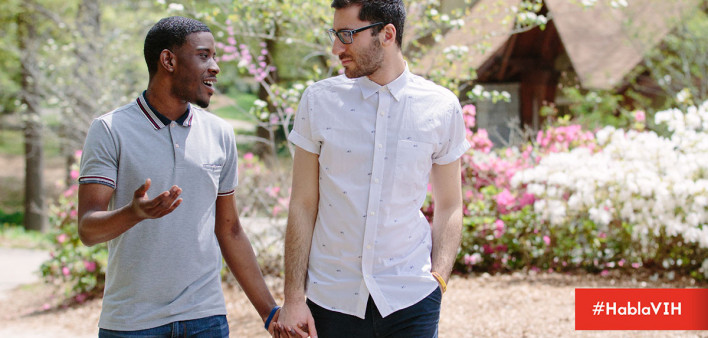Tuesday, September 27, marks National Gay Men’s HIV/AIDS Awareness Day 2022 (#NGMHAAD). Although the number of HIV cases among gay and bisexual men has decreased since 2015, this population continues to be disproportionately affected by the virus. In 2019, for example, 70% of the estimated 34,800 new HIV cases in the United States were among gay and bisexual men and other men who have sex with men (MSM), reports the Centers for Disease Control and Prevention (CDC).
Sample posts and tweets about the awareness day are embedded throughout this article. For more and to find events near you, search #NGMHAAD.
September 27 is National Gay Men’s HIV/AIDS Awareness Day, a day to help stop HIV stigma and encourage HIV testing, prevention, and treatment among gay and bisexual men. https://t.co/ItVtbU0AOR #NGMHAAD #StopHIVTogether #blacklivesmatter#StopHIV #EndAIDS #Get2ZeroHIV pic.twitter.com/P9MiaslQM1
— New Haven Mayor’s Task Force on AIDS (@nhmtfa) September 26, 2022
The awareness day is an opportunity to fight stigma and encourage testing, prevention and treatment among gay and bisexual men. This year, it’s also a chance to raise awareness about monkeypox and the vaccine to prevent it. As the leaders of the CDC’s Division of HIV Prevention write in a blog post:
“As we celebrate the progress we have made in HIV prevention and treatment among gay and bisexual men, we must also acknowledge the challenges we still face. Racism, poverty, stigma and homophobia serve as barriers to care and prevention and continue to drive inequities that cause gay and bisexual men—particularly Black/African-American and Hispanic/Latino men—to be overrepresented in the HIV epidemic.
“This NGMHAAD, we acknowledge the additional public health challenges and continued stigma that gay and bisexual men face. Although we are still learning about monkeypox amid the current outbreak, we are seeing similar patterns of inequity, with Hispanic/Latino and Black/African-American gay and bisexual men representing the majority of people with monkeypox. Recently, CDC released a Morbidity and Mortality Weekly Report showing that people with HIV and with a recent history of other sexually transmitted diseases (STDs) are disproportionately affected by monkeypox. This represents an important opportunity to use existing HIV and STD prevention and care models and resources to ensure equitable access to monkeypox information and services among gay and bisexual men, people with HIV, and people who experience increased incidence of STDs. Learn more about the CDC’s efforts to reduce stigma in monkeypox communication and community engagement.”
More information about NGMHAAD is available from the team at AIDSVu.org, which creates interactive maps and graphics based on HIV and PrEP (pre-exposure prophylaxis) data. AIDSVu notes that between 2008 and 2019, Black gay and bisexual men saw a 2% decrease in new HIV diagnoses, while Latino gay and bi men saw an 18% increase during the same period. This compares with a 34% decrease experienced by their white counterparts.
People under 35 represented more than half of all new #HIV diagnoses among Gay and Bisexual Men in 2019 -- explore the age breakdown for #NGMHAAD: https://t.co/zgjMyeNlLM pic.twitter.com/B1gSm68Dyo
— AIDSVu (@AIDSVu) September 28, 2021
Similar racial disparities persist across the HIV care continuum, including linkage to care and viral suppression.
An important tool to prevent HIV is PrEP in the form of the daily pills or long-term injections that are highly effective at preventing a person from contracting the virus. However, as AIDSVu points out in an interview with Patrick Sullivan, DVM, PhD, PrEP uptake varies by region and race.
For example, AIDSVu data show that Black people made up 14% of PrEP users in 2021 but 42% of new HIV cases in 2020, while white people made up 65% of PrEP users and 25% of new HIV cases in the same period. (Note: This is among all users and HIV cases, not only gay and bisexual men).
View this post on Instagram
“We know some, but not all, of the answers to why Black people are underserved by PrEP relative to the impact they experience in the HIV epidemic,” Sullivan said in the interview. “Black people are more likely to live in the U.S. South, where Medicaid expansion is less common and where public PrEP Drug Assistance Programs (DAP) are not common. Levels of PrEP use are higher in states that have one or both of these types of health coverage programs. We also know that the distance to a PrEP provider makes a difference in whether people are able to easily access PrEP; people who live in rural areas may have substantial commutes to get to a place that provides PrEP care. Further, experienced or anticipated stigma surrounding PrEP use can discourage people from starting PrEP. Minimizing barriers—especially in terms of co-pay requirements and convenient access to PrEP providers—are high priorities. Building capacity to offer PrEP through multiple channels, including telehealth programs, can also mitigate some of these barriers to PrEP use.”
The CDC created a fact sheet titled “HIV and Gay and Bisexual Men” that’s available as a PDF full of infographics. The latest data show that in 2019, about 1.2 million people were living with HIV in the United States. Of those, 754,700 were gay and bisexual men.
National Gay Men’s HIV/AIDS Awareness Day 2022
— CLEHIV (@CLEHIVtrials) September 26, 2022
Twitter Chat with @HealthHIV and Partners
Tuesday, September 27 at 1:00pm EDT#NHMAHIVchat #NGMHAAD pic.twitter.com/yncdlhkJEd
Finally, for details about other HIV awareness days, including a calendar you can download and print, visit “2022 HIV/AIDS Awareness Days.”







Comments
Comments